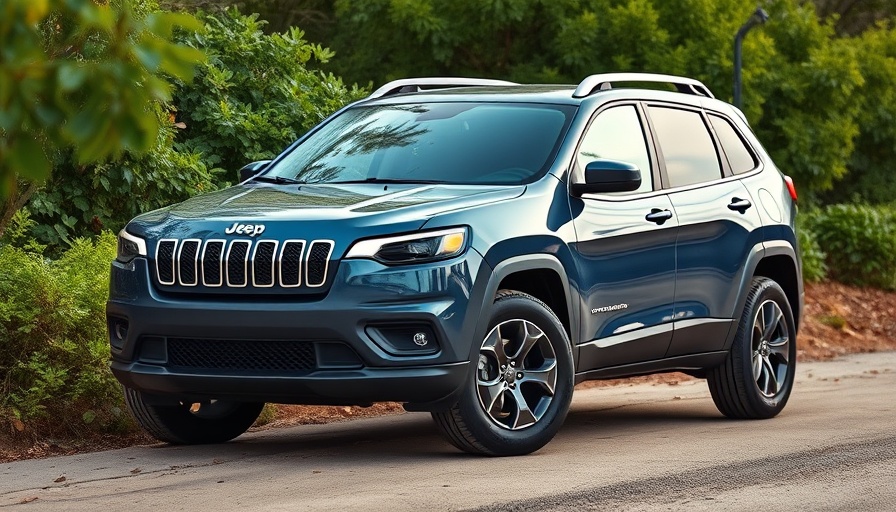
The Revival of the Jeep Cherokee: A Hybrid Makeover
The Jeep Cherokee is making a bold comeback in 2026 after its temporary hiatus in 2023, undergoing a significant transformation into a hybrid-only SUV. With a renewed focus on efficiency, space, and style, Jeep aims to compete in a saturated market filled with options for eco-conscious consumers looking for family vehicles.
Power and Performance: What’s Under the Hood?
The 2026 Cherokee boasts a new 350-volt hybrid system that pairs a turbocharged 1.6-liter four-cylinder engine with an electronically controlled CVT (continuously variable transmission) and a compact 1.08-kilowatt-hour battery. This innovative design promises an impressive 210 horsepower and 230 pounds-feet of torque. With over 500 miles of range and an expected 37 miles per gallon fuel efficiency, it’s clear that Jeep is looking to impress both off-road enthusiasts and daily commuters alike.
Room to Grow: Space and Cargo Capacity
In terms of dimensions, the 2026 Cherokee has increased its size markedly. With a length of 188.1 inches and an extended wheelbase of 113.0 inches—roughly six inches longer than its predecessor—this new model provides a notable 30 percent increase in cargo capacity. Families craving more space for weekend trips or those needing extra room for gear will likely appreciate the enhanced design when the liftgate opens.
Utility and Capability: Designed for Adventure
Catering to Jeep's adventurous buyers, every trim of the Cherokee is equipped with the Active Drive I 4×4 system, which includes a rear axle disconnect. This system, coupled with the Selec-Terrain feature that offers modes for various driving conditions—Auto, Sport, Snow, and Mud/Sand— ensures that the vehicle meets the needs of outdoor enthusiasts. The anticipated Trailhawk variant of the Cherokee is also on the horizon, promising even greater capability for those looking to explore more rugged terrains.
A Nod to Heritage: Style Features
While the new Cherokee incorporates modern aesthetics, it doesn’t shy away from its storied heritage. The design features a clean, boxy exterior reminiscent of the classic CJ models, with U-shaped daytime running lights and tasteful nods to vintage Jeep styles. This thoughtful blend of past and present aesthetics ensures that the Cherokee remains instantly recognizable while appealing to a new generation of drivers.
Inside the Cabin: Modern Comfort and Technology
Stepping inside the Cherokee reveals a sophisticated interior that sports a modern, upscale vibe—something seen in recent Jeep models. The inclusion of a 10.25-inch digital gauge cluster and a 12.3-inch center display running Uconnect 5 with wireless Apple CarPlay and Android Auto connectivity enhances the driving experience, making it both pleasurable and practical. Added features such as clever storage solutions and a new rotary gear selector free up cabin space, adding to driving comfort.
Safety Features and Pricing: Investing in Secure Driving
The Cherokee is designed with safety in mind, offering standard equipment like blind-spot monitoring, active emergency braking, and rear park assist. Optional features that can enhance safety and comfort include a 360-degree camera system, ventilated front seats, and a dual-pane sunroof. As for pricing, the Cherokee starts at $38,990, offering a competitive rate for a hybrid SUV in its class.
The Future of the Jeep Cherokee: Insights and Expectations
Overall, the new Jeep Cherokee is ushering in a promising future for the brand. With its effective combination of heritage design, modern technology, and real-world efficiency, Jeep appears poised to reclaim its space in the highly competitive SUV market. As we look to the upcoming Trailhawk and more details on trim offerings, let’s keep our eyes open to what this revitalized classic will bring to the roads.
A Call to Action
For both adventurous spirits and families seeking reliable options, the 2026 Jeep Cherokee not only embodies modern automotive design but exemplifies a commitment to sustainability and performance. If you’re in the market for a hybrid vehicle that doesn’t compromise on style or functionality, consider checking out local dealers and discovering the Cherokee for yourself. Take the step towards a more efficient driving experience today!
 Add Row
Add Row  Add
Add 




Write A Comment